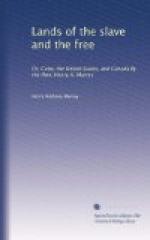The State of New York may fairly claim the credit of having executed one of the most—if not the most—valuable public works in the Union—the Erie Canal. At the time of its first proposal, it received the most stubborn opposition, especially from that portion of the democratic party known by the appellation of “Barn-burners,” whose creed is thus described in a pamphlet before me:—“All accumulations of wealth or power, whether in associations, corporate bodies, public works, or in the state itself, are anti-democratic and dangerous.... The construction of public works tends to engender a race of demagogues, who are sure to lead the people into debt and difficulty,” &c. The origin of their name I have not ascertained.
Another party, possessing the equally euphonical name of “Old Hunkers,” are thus described:—“Standing midway between this wing of the Democracy and the Whig party, is that portion who have taken upon themselves the comfortable title of ‘Old Hunkers.’ The etymological origin of this epithet is already lost in obscurity. They embrace a considerable portion of our citizens who are engaged in banking and other active business, but at the same time decided lovers of political place and power. At heart they believe in progress, and are in favour of a liberal prosecution of works of improvement, but most generally disguise it, in order to win the Barn-burners’ votes. They are by no means deficient in intelligence or private worth, but are deeply skilled in political tactics; and their creed, if it is rightly understood, is that public works ought to be ‘judiciously’ prosecuted, provided they themselves can fill all the offices of profit or honour connected with their administration."[AZ]
Such is the description given of these two parties by the pen of a political opponent, who found in them the greatest obstacles to the enlargement of the canal.
The name of De Witt Clinton will ever be associated with this great and useful work, by which the whole commerce of the ocean lakes is poured into the Hudson, and thence to the Atlantic. After eight years’ hard struggle, and the insane but undivided opposition of the city of New York, the law for the construction of the canal was passed in the year 1817. One opponent to the undertaking, when the difficulty of supplying water was started as an objection, assisted his friend by the observation, “Give yourself no trouble—the tears of our constituents will fill it.” Many others opposed the act on the ground that, by bringing the produce of the States on the lake shores so easily to New York, the property of the State would be depreciated; which appears to me, in other words, to be—they opposed it on the ground of its utility. Others again grounded their objections on the doubt that the revenue raised by the tolls would be sufficient to justify the expense. Fortunately, however, the act was carried; and in seven years, the canal, though not quite completed, was receiving tolls to the amount of upwards of 50,000l. In 1836 the canal debt was paid, and produce valued at 13,000,000l.—of which 10,000,000l. belonged to the State of New York—was carried through it; the tolls had risen to 320,000l. per annum, and 80,000l. of that sum was voted to be appropriated to the general purposes of the State, the total cost having been under one and a half million sterling.




